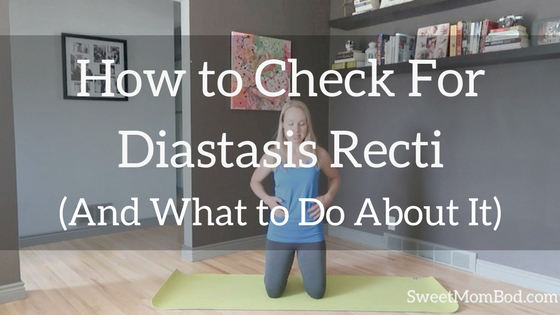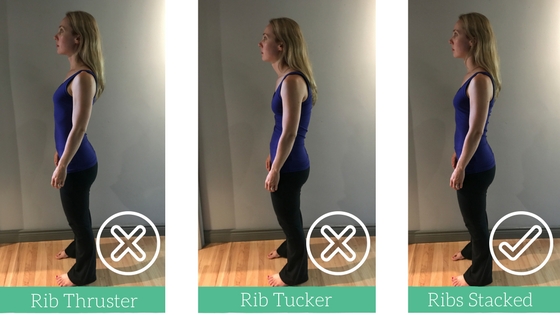
Think you might have diastasis recti?
If you …
Have a post-baby belly that just won’t go away no matter how healthy you eat or how many crunches you do.
Suffer with nagging back pain and just feel like your core is weak (despite all the planks you’ve been doing).
Pee yourself from time-to-time. Maybe just a little. But still.
… You could have diastasis recti – a separation of the two sides of your rectus abdominis (your “six-pack abs”).
Don’t freak out! Your abs are supposed to separate during pregnancy – especially if you’re growing 2 or more kiddos in there. For some women though, the abs don’t naturally come back together after baby comes out so they’re left with a gap between the two sides of their rectus abominis muscles.
I’ll go into more detail in the video, but the truth is that the gap is not the major issue. The most important issue to pay attention to is the lack of function.
When you have a diastasis you may be dealing with all kinds of negative side effects. Like back pain, a weak pelvic floor (often a weak pelvic floor and core go hand-in-hand because everything in your body is connected and these two systems work closely together), and leaking or full-on losing control of your bladder when you run, cough, jump, sneeze or laugh.
This video will tell you a bit more about diastasis recti and show you how to do a self-check to figure out if you have it or not.
It’s also important to know that properly engaging your core and pelvic floor during the self-test may help your rectus abdominis muscle respond better (the two sides of your six-pack abs might come closer together and the gap may not be as deep when you engage your core and do a kegel).
So when you do the self-test, first try doing it without engaging your core and pelvic floor and then try doing it while engaging your core and pelvic floor.
Do you feel a difference?
Does the gap change when you engage your core and pelvic floor? Is it smaller or less deep?
If it changes for the better, that’s a good sign that your ab muscles are responding when you actively focus on engaging them. Which means that your entire core will be better supported during exercise if you know how to properly engage your core – even if you’re still working on closing the gap.
Remember – it’s not about the gap. It’s about the lack of function.
You can still have a well functioning core without closing your gap completely.
Found out you’ve got it?
Here’s what you need to do next:
Step One: Learn to Engage Properly
The first step to ensuring your core and pelvic floor work well together – so you can help heal your diastasis – is knowing how to properly engage your core.
After all, if you’re going to be doing core exercises to help heal your core, you might as well get the most out of them, right?
So give this quick video a watch and practice properly engaging your core.
Remember – it’s a small action. Nothing major. Just a slight lift and pull.
Step Two: Get Aligned
Are you a rib thruster? A bum tucker? Belly sucker-inner?
Alignment and proper breathing mechanics may not be as sexy a topic to talk about as ab exercises, but the truth is how you sit, stand and move the other 16+ hours out of the day you’re not working out (or sleeping) has a huge impact on how quickly and how well you heal.
The truth is that if your body bits aren’t stacked well on top of one another (AKA they aren’t aligned well) that can actually make it harder for your body to heal.
Part of the problem is that, if you’re out of alignment, that could be putting more pressure on your rectus abdominis. And if there’s more pressure on your rectus abdominis, what do you think can happen to that gap?
It can get worse, or simply not get better.
It’s like squeezing a water balloon as hard as you can and expecting it to never pop. Some day it’ll pop.
So we want to get you in more optimal alignment to help your body heal and stay healed.
There are a few different cues you want to keep in mind, let’s talk about 3 of the most important ones.
We want your…
- Ribs stacked over top of your pelvis (this means your chest isn’t puffed out or caved in)
- Butt untucked
- Belly relaxed

Practice these cues when you’re sitting, standing, walking and doing your exercises. Make it a habit and not only can it help heal your diastasis, it can help ensure your core (and entire body) is as strong as possible.
Step Three: Check-In With a Pro
I highly – highly – recommend that you find a great pelvic floor physiotherapist or physical therapist in your area so she can give you a full assessment – especially if you think you may be dealing with more than just diastasis (perhaps you’re worried about prolapse or incontinence).
Here are some links to help you find a physiotherapist or physical therapist near you (If your country isn’t on the list, I apologize. There aren’t directories for every country. Try typing “find a pelvic floor physiotherapist/physical therapist + your country” into Google and hopefully some great pros will be available):
Step Four: Ditch Those, Pick Up These
The last step we want to chat about is ditching the planks and crunches and picking up some better exercises for your core rehab.
It’s not that planks and crunches are “bad” they just have a tendency to do the opposite of what we want – they could make your diastasis worse, or make it harder for it to heal if we’re not careful.
I don’t want to scare you – especially if you’ve been doing planks and crunches like crazy hoping they’ll make your post-baby pooch go away.
It’s okay. No matter where you’re at, or how long ago you had your baby, or what exercises you’ve been doing up until now, there’s hope. You can regain strength, function and tone with the right exercises.
It doesn’t matter what you’ve done up until now, let’s focus on moving forward with the best treatment protocol in mind.
You can start by doing some diastasis-friendly, simple core workouts designed by a trusted fitness pro (like me) who knows a lot about the dos and don’ts of healing diastasis (as well as how to breathe well and be properly aligned during each exercise and in every day life).
[embed_popupally_pro popup_id=”7″]
Just make sure to check-in with your doctor or physio first to make sure any exercises you’re doing are right for your body – there’s no one size fits all approach to healing diastasis, weak core, and pelvic floor issues. Every body is different so we want yours to get what it needs.
You don’t have to live with the pain and the “this isn’t what I want my body to look or feel like” thoughts.
You can help your body heal and feel stronger.
It’ll take some time and patience but you grew a person. A person! You’re pretty darn amazing so I have a feeling you’re up for the challenge.
Dive into the 4 steps and definitely shoot me a message if you have any questions. I’d love to hear from you.
I know diastasis can feel scary. But it doesn’t have to be. It’s your body’s natural reaction to pregnancy and you can feel, function and look better.
This isn’t just your life now.
There’s always hope. And I’m here to help.
Hugs,
Jen
P.S. Have a friend who’s bummed out by her post-baby belly? Send her this video and suggest that she check for diastasis and get some help healing it.
Leave a Reply